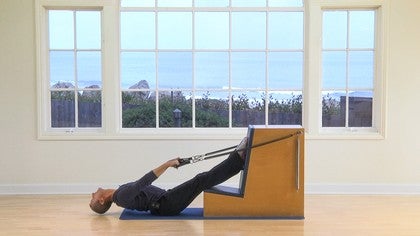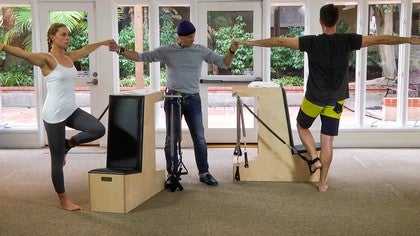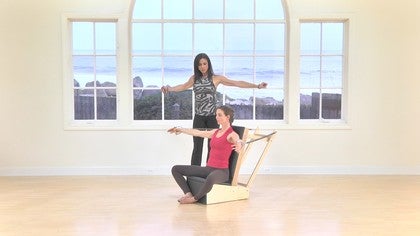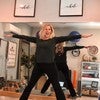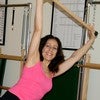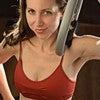Description
About This Video
Transcript
Read Full Transcript
Hello everybody. I'm Judy in Little Ford and I own and operate JL body conditioning polarities in del Mar, California. I'm standing next to a piece of equipment called the arm chair and it's manufactured by balanced body out of Sacramento. I've been using this piece of equipment for 35 years and I think personally that is one of the greatest pieces of equipment in a plotted studio, although it's very rarely used. I have a whole syllabus on it, working everything from the upper torso through the torso, from the arms to the legs to standing work to prone to Supine to flection and extension to flection extension with rotation. Anyway, I'm not going to talk anymore or tell you about what it can do, but I'm going to show you some of the exercises that we've come up with over a period of 35 years. As I said, I've been lucky enough to be teaching a long time and I've been lucky enough to work with a lot of different professional athletes, football hall of famers and two two hall of famers on the um, baseball side.
My pitchers and my quarterbacks absolutely love this work purely and simply because of the range of motion and the ability to be able to get into the shoulder girdle and then connect the rest of the body with it. So without further ado, I'm going to sit down here and I'm going to show you some of the exercises that we've got together. Okay. I place a ball between the knees and the reason why the ball is there is I'm not crushing the ball, okay? I want it to switch off the hip flexors. I want the adductors just to activate and I want the back of the leg to be active. You're going to push down through the heels, so we work the back of the leg and the shoulder blades are down. I'm going to take you through some small range of motion, very simple, just basic scapular stabilization with the arm moving.
Now this resistance that I have here is not particularly hard. It's also not particularly light. As you get closer, as the spring resistance gets closer to the back of the chair, the resistance gets more. So I'm using a medium style or medium weight spring should I say. So basic humorous rotation into the arms coming up. Shoulder blades are down. Go into full range of motion.
Notice that the springs do not relax. The adductors abductors hamstrings, arches, medial side of the arch. Trapezius is relaxed. I'm working pretty much everything. Now you might be saying, what's the benefit of doing this versus the arm work that we do say on the reformer or the Cadillac? Well, the great thing about when you are sitting is that you switch off the hip flexors and we know that if you sit on Mat, a reformer that is very difficult for men to sit up at their hamstrings are very tight. So we get this look, when you release the hamstrings, you can work on the shoulder girdle if that's what we're deciding to work on with this piece of apparatus. Okay, now we're going to incorporate some other muscle groups now. Okay, so I'm going to bring the head, shoulders down and forward and we work on forward flection with resistance. Nice and calm. The great thing about having the seats there is that my spinal column thing.
Go back into it so there's no chance of me hyperextending my back. I'm really imprinting my spinal column back against the back of the seat. Now for reflection and we go into rotation,
Rotate with extension of the leg and down. So you're adding muscle groups as the exercise gets longer in duration and consequently it makes it a little bit harder. Judging by my breath, you're probably noticing that hopefully it looks easier than it really is. If we turn around. The great thing about when you're turning around facing it is not only as a teacher can you get to see which muscle groups are working, but you can also put the client where they need to be. So for example, we can start low basis scapula stabilization. We work the same muscle groups in the legs because you're squeezing the side shoulder blades down. You gently pull the arms to the start position, which is level with the hips and you gently small pulses back.
Nothing moves. It becomes a little harder. A 45 becomes brutally interesting at 90 degrees, okay, and gently down. We can do some basic tricep extension, but when you keep, as I said, the arms straights, you recruit the triceps and the lats and stabilize the scapula where it needs to be. You will feel all of these muscles, muscle groups working. We also get to the point where we can lay down and use these springs to help.
When, for example, we are going into something like a preparation for the teaser. The sacrum is down and you're using the springs to come up, not tilting the pelvis. The sacrum stays down so you can, the lumbar spine gets a little bit more intense. Okay, so the work is not when you're coming forward. The work is when you're pulling back, elongating that spinal column back Nice and calm. We put them all up with a thoracic extension to it and deepen. Draw the abdominal wall in and the crown of the head goes back.
Posterity. Tilt the pelvis and come forward and that of course, what you do, one way you have to do the other and slew down makes it a little bit more interesting with a contraction, just basic roll, a rowing or with the spine completely released. Now that's very interesting, but what do we do when we want to turn around and we want to use rotation with flexion and extension. We have some exercises thus, so we started with the arm pullbacks as we did and that, as I said, gets progressively harder when the arms come out. Okay. Now what happens when we turn around and we rotate or extend the arms and down and forward. You can imagine how the eyebrows went up when the pitchers started to use this. Okay. They hadn't ever felt all of these muscles in the spring. Resistance is so different when you're using a single weight. Okay.
The east century concent, you can traction in the muscle groups is really what makes this so special. The angle at which the springs come out is what makes it so different to being than versus doing it on the reformer. She'll be. I, as I said, absolutely love this piece of equipment. For those of you who know the way that I've run my studio, I do a circuit. I always have the armchair in it and it always gets more difficult. We've done some facing front facing back. We've done some some supine.
Now we're going to work the legs a little bit and you might think, well, okay, how can we do in, here's how can we do standing here? We just basically place the foot in the strap, so we come out and we work as doctors and then of course on top of that we work balance, very important balance. As you see, I am not balanced today. There we go. Okay, we can come up onto elevate if need be. You can turn around and you can work it going forward and pulling back and forward so it's not just adductors, just hamstrings. Then what happens to fire the correct muscle or work the muscle groups that we want. Letting the client know which must've grew through.
Once we lay down the hamstrings, trust me, they're working [inaudible] and gently down, extending out a little bit further. And then of course, if you want more resistance, you would extend your leg all the way onto the front of the seat here. Once again, I said the great thing with this piece of apparatus is, hey, you can play on it, be it is really intense. It doesn't give you a gentle, warm up. And yet we can simplify the exercises to make them a gentle, warm up.
So everybody from my oldest client who's 97 two, my youngest, who's 15 right, gets to use the arm chair every single day that they come in. And I think that it's by far the range of motion that you can get and the ability to not hurt your back. Um, during the exercises. That's what it is. That's what it's about. Thank you. I look forward to expanding some more about it later on.
The Teacher's Corner - Playlist 18: Arm Chair Classes
Comments
Thanks again Julian...can't wait to see more!
Thank you, J
You need to be a subscriber to post a comment.
Please Log In or Create an Account to start your free trial.
